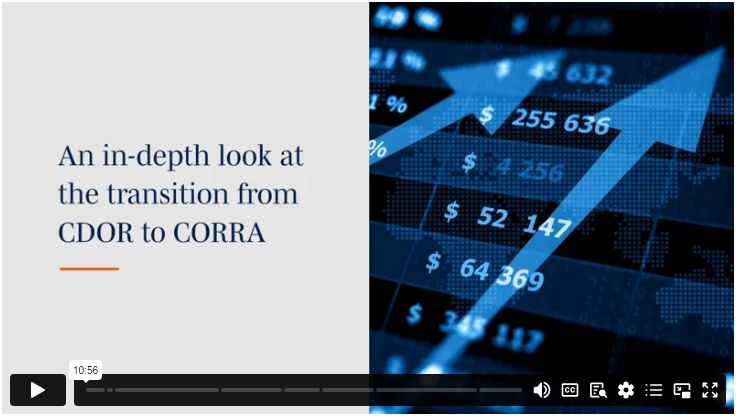Video transcript
Simon Williams (00:05): In just over a year from now, on June 29th, 2024, the entirety of Canada's loans, derivatives and bonds markets, about 20 trillion in notional value, is going to toggle from CDOR to a new benchmark rate that very few people have heard of called "CORRA". And while you may have heard of this transition as upcoming, today, we're going to unpack a little bit of the background on this.
Simon Williams (00:43): This is really a story of CDOR being guilty by association due to the trouble its big brother LIBOR got into back in 2012. And some may remember very large billion dollar fines handed out by regulators to firms that were found guilty of manipulating the price of LIBOR. So the first element is: Why is LIBOR able to be manipulated?
And that's really about how it's derived. And the way that happens is someone at the British Bankers' Association would call a panel bank and speak to likely an analyst there and simply ask the question: At what rate can your institution borrow funds unsecured in the London interbank market for a period of one or three months, for example.
So at best you had the element of human forecast. Then you had that human being making a projection about where they thought borrowing costs were headed over the next period of time. But worse, and this was pre-Volcker era, you had those banks running prop desks as well. And so that same institution, maybe short interest rate futures, for example, and therefore have a financial incentive to manipulate LIBOR and tilt it in one direction or another.
And because LIBOR was a fundamental rate, the baseline rate for hundreds of trillions of dollars in notional contracts, that would have a distortive effect on the entire cost of funds globally. So bonds, home mortgages, etc. were being effectively mispriced because of this manipulation. So that, the LIBOR scandals, coupled with the post-2008 global financial crisis, move towards greater regulation, more transparency, deleveraging among financial institutions, etc. was really the impetus for the United States in particular to initiate reforms to move away from the LIBOR rate, given its susceptibility to manipulation and human error, and towards a risk-free rate. So in the US, that was the move from LIBOR to SOFR. And in Canada this is the move from CDOR to CORRA, with CORRA and SOFR both being risk-free rates.
Simon Williams (03:23): Risk-free rates represent a pure proxy for the economic cost of borrowing. This is simply based on the supply and demand of money, the central banks' and governments' monetary policy, and do not and effectively strip out the factors such as credit risk and the time value of money. And because the risk-free rates do not contain a credit premium or a credit spread or a time premium, time value of money premium, they are nominally lower rates.
So when we move an existing loan contract from CDOR a higher interbank rate to a lower risk free rate, it's not like the borrower just suddenly gets a cheaper cost of funds or its loans get cheaper. So the idea of this process is to keep the parties in an economically neutral situation. And because of that, we have to add a fudge factor, if you will, to solve for that difference in premium, to represent the fact that we don't have a credit risk premium or time value of money premium. And the ARRC, in the case of LIBOR, and the CARR (Canadian Alternative Reference Rate Committee) in the case of Canada, have determined or at least recommended what that credit spread adjustment or fudge factor should be.
Simon Williams (04:58): It's also interesting to note that while risk free rates and interbank rates generally move in tandem together, that's not always the case. And in times of economic duress or credit shocks, anything with credit risk tends to blow out. And so in March 2020, when there was a lot of fear in financial markets and the economies in general, we saw that LIBOR spread blow out significantly over the SOFR rate.
And for that reason, the risk-free rates can be seen as favourable to borrowers because they tend to stay lower regardless of the shock, as opposed to having a credit shock where CDOR or LIBOR as an interbank rate spikes. And then the borrower is then paying that higher cost for the duration of that, of the credit shot.
Simon Williams (05:55): CORRA is based on actual data, but it is an overnight rate, whereas CDOR is a term rate. So from a borrowing perspective, CDOR does have its advantages because at the beginning of a borrowing period, the borrower can look at a Bloomberg terminal and know what the three-month CDOR rate is and fix its cost of funds for that three-month period.
For CORRA, however, because it's a daily rate, the borrower essentially has to wait through the entire three months, or close to it, and then all the individual daily CORRA rates are summed and averaged. And only then at the end of the period does the borrower know what its cost of funds were. Because of that, the CARR has come up with a term CORRA rate, but this is essentially a synthetic rate because it's converting a daily rate into a time-bound rate, and it's using the futures market to do that. That term CORRA rate is underway and being developed and is expected to be officially published and sanctioned by Bank of Canada and the CARR later this year.
Simon Williams (07:17): Now, interestingly, in contrast to the LIBOR to SOFR transition, which took place gradually over time with different deals and different banks being able to elect to initiate the transition mechanics gradually and in sort of a drip feed fashion, the move from CDOR to CORRA is actually binary. So the entire market is going to flip from CDOR to CORRA on June 29th, 2024.
And so that begs the question: What to do with contracts that will continue to be in existence after that cliff date in June 2024 that reference CDOR? And so the CARR has published a series of amendments which are essentially like an organ. You can think of it as an organ transplant that gets inserted into the documents via amendment, and provides that the parties agree that on June 29, 2024, once CDOR goes away, that the loan mechanics will flip to either term CORRA, which is most likely the case, and loan deals, or a form of daily CORRA.
And CARR has published a two-pronged or two-stream approach treating securities and derivatives products differently, and that in recognizing those are better suited to daily CORRA, and those are moving a little faster. And so as of the end of June 2023, any new bond securities or derivatives products are required to reference CORRA. So no new instruments can reference CDOR from this point forward.
There's a little more of a runway for CDOR, another year, which is good news because as of right now, there isn't a officially recognized published term CORRA rate, but the expectation is that will be in place well before the June 2024 deadline. And in addition to the CDOR to CORRA mechanics, there is also a secondary fallback, you know, safety net that in the event CORRA ever becomes non-representative of borrowing costs or has other issues with it, that there's a contractual framework in place for the parties to arrive at a another fallback rate-a fallback to the fallback rate.
Simon Williams (09:52): One final point to note, that's relevant to deals that have both a loan and an interest rate hedge, is that where term CORRA is generally preferable for loan agreements, it's more expensive to hedge a term CORRA benchmark rate than daily CORRA due to just the construction of that rate, thinner liquidity etc.
And so borrowers can either look at if they want to have no
basis mismatch between the benchmark rate and the loan versus the
hedge, they'll have to tolerate slightly higher hedging costs.
Or what we are seeing as well is borrowers having term CORRA under
the loan agreement and then hedging based on daily CORRA. So there
is a marginal basis differential there, generally pretty small, but
that results in lower transaction fees overall.
While most market players have heard that the Canadian Dollar Offered Rate (CDOR) will cease publication in June 2024, understanding the full scope of this change-and why it is happening in the first place-can shed light on how to best move forward under CORRA's "new normal".
Simon Williams fills in the blanks about this transformation for Canada's loans, derivatives, bonds and securitizations, representing about $20 trillion in value. As CDOR is replaced by the Canadian Overnight Repo Rate Average (CORRA), dealmakers and others involved with financial contracts need to take steps to adapt.
In this video, Simon explains:
- The differences between CDOR and CORRA
- Why CDOR's demise is linked to the 2012 LIBOR scandal
- What has changed already and what will change next year
- How to proceed on deals involving both a loan and an interest rate hedge
The content of this article is intended to provide a general guide to the subject matter. Specialist advice should be sought about your specific circumstances.

